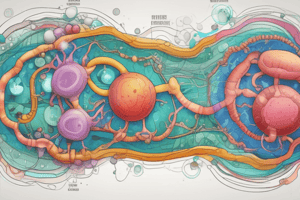Podcast
Questions and Answers
What is the primary factor that influences the rate of diffusion?
What is the primary factor that influences the rate of diffusion?
- Type of membrane involved
- Temperature of the surroundings
- Surface area of the membrane
- Concentration gradient (correct)
Which type of membrane allows only certain molecules to pass through?
Which type of membrane allows only certain molecules to pass through?
- Fully permeable membrane
- Impermeable membrane
- Partially permeable membrane (correct)
- Semipermeable membrane
What type of solution would cause a plant cell to swell due to osmosis?
What type of solution would cause a plant cell to swell due to osmosis?
- Concentrated salt solution
- Hypertonic
- Isotonic
- Hypotonic (correct)
What happens to an animal cell when it is placed in a diluted solution?
What happens to an animal cell when it is placed in a diluted solution?
What is the term for the movement of water molecules from high water potential to low water potential through a partially permeable membrane?
What is the term for the movement of water molecules from high water potential to low water potential through a partially permeable membrane?
What is the primary function of osmosis in cells?
What is the primary function of osmosis in cells?
What would happen to a red blood cell placed in a concentrated salt solution?
What would happen to a red blood cell placed in a concentrated salt solution?
What is the primary function of active transport in living organisms?
What is the primary function of active transport in living organisms?
Why can't glucose molecules move into cells via osmosis?
Why can't glucose molecules move into cells via osmosis?
Which of the following is an example of osmosis in plant cells?
Which of the following is an example of osmosis in plant cells?
What is the main difference between diffusion and osmosis?
What is the main difference between diffusion and osmosis?
What is the characteristic of the cell membrane that allows osmosis to occur?
What is the characteristic of the cell membrane that allows osmosis to occur?
Which of the following is NOT an example of transport across a cell membrane?
Which of the following is NOT an example of transport across a cell membrane?
Flashcards are hidden until you start studying
Study Notes
Transport Systems in Organisms
Diffusion
- Definition: Movement of particles from high concentration to low concentration, down a concentration gradient
- Influenced by the concentration gradient; steeper gradient results in faster diffusion
- Occurs in gases, liquids, and dissolved substances, with or without a membrane
- Types of membranes:
- Fully Permeable: All molecules can pass through
- Impermeable: No molecules can pass through
- Partially Permeable: Only certain molecules can pass through
- Examples in living organisms:
- Gas exchange in lungs
- Nutrient absorption in intestines
Osmosis
- Definition: Net movement of water molecules from a region of high water potential to low water potential through a partially permeable membrane
- Water potential gradient influences the rate of osmosis
- Water potential:
- High: More water molecules, less solute concentration
- Low: Fewer water molecules, higher solute concentration
- Osmosis in living systems:
- Animal Cells (e.g., red blood cells):
- In diluted solution: Water enters the cell, causing it to swell and possibly burst
- In concentrated solution: Water leaves the cell, causing it to shrink and crenate
- Plant Cells:
- In diluted solution: Water enters the cell, making it turgid
- In concentrated solution: Water leaves the cell, causing plasmolysis
- Animal Cells (e.g., red blood cells):
Transport Across Cell Membrane
- Diffusion: e.g., oxygen uptake and carbon dioxide excretion during respiration
- Osmosis: e.g., water uptake by root hair cells
- Active Transport: e.g., uptake of mineral salts by root hair cells, glucose, and amino acids by epithelial cells in the small intestine
Studying That Suits You
Use AI to generate personalized quizzes and flashcards to suit your learning preferences.





